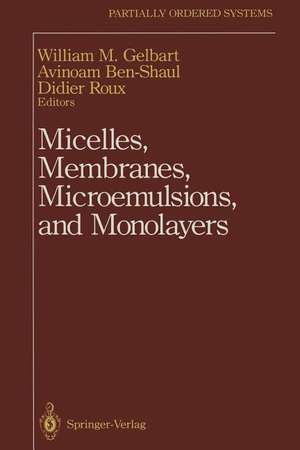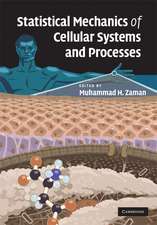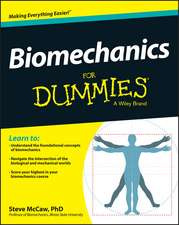Micelles, Membranes, Microemulsions, and Monolayers: Partially Ordered Systems
Editat de William M. Gelbart, Avinoam Ben-Shaul, Didier Rouxen Limba Engleză Paperback – 15 noi 2011
Preț: 407.19 lei
Nou
Puncte Express: 611
Preț estimativ în valută:
77.94€ • 84.69$ • 65.51£
77.94€ • 84.69$ • 65.51£
Carte tipărită la comandă
Livrare economică 21 aprilie-05 mai
Preluare comenzi: 021 569.72.76
Specificații
ISBN-13: 9781461383918
ISBN-10: 1461383919
Pagini: 628
Ilustrații: XVI, 608 p.
Dimensiuni: 155 x 235 x 33 mm
Greutate: 0.87 kg
Ediția:Softcover reprint of the original 1st ed. 1994
Editura: Springer
Colecția Springer
Seria Partially Ordered Systems
Locul publicării:New York, NY, United States
ISBN-10: 1461383919
Pagini: 628
Ilustrații: XVI, 608 p.
Dimensiuni: 155 x 235 x 33 mm
Greutate: 0.87 kg
Ediția:Softcover reprint of the original 1st ed. 1994
Editura: Springer
Colecția Springer
Seria Partially Ordered Systems
Locul publicării:New York, NY, United States
Public țintă
ResearchCuprins
1 Statistical Thermodynamics of Amphiphile Self-Assembly: Structure and Phase Transitions in Micellar Solutions.- 1.1 Introduction.- 1.2 Amphiphile Self-Assembly in Dilute Solutions.- 1.3 Molecular Organization of Aggregates.- 1.4 Interaction Effects in Dilute Solution and Beyond.- 1.5 Concluding Discussion.- 2 Micellar Growth, Flexibility and Polymorphism in Dilute Solutions.- 2.1 Introduction.- 2.2 Globule to Rod Transformation.- 2.3 Polymerlike Behavior.- 2.4 Bidimensional Aggregation.- 2.5 The Physical Basis of Micellar Polymorphism.- 2.6 Connection with Microemulsions.- 3 Micellar Liquid Crystals.- 3.1 Introduction.- 3.2 Nomenclature.- 3.3 Preparation of Stable Nematic Phases.- 3.4 Factors Governing Size and Shape of Micelles in Concentrated Solutions.- 3.5 Experimental Characterization of Nematic Phases.- 3.6 Phase Transitions in Micellar Solutions.- 3.7 Conclusions.- 4 Geometrical Foundation of Mesomorphic Polymorphism.- 4.1 Introduction.- 4.2 Mesophases as Structures of Films.- 4.3 Frustration, Curved Spaces and Disclinations.- 4.4 The Periodic System of Parallel Films.- 4.5 Comments.- 4.6 Conclusion.- 4.7 Appendix.- 5 Contents Lamellar Phases: Effect of Fluctuations (Theory).- 5.1 Introduction.- 5.2 Model of Isolated Membranes.- 5.3 Membranes in Interaction.- 5.4 Conclusion.- 5.5 Appendix.- 6 Lyotropic Lamellar L? Phases.- 6.1 Introduction.- 6.2 Phase Diagrams.- 6.3 Membranes and Smectic Properties.- 6.4 Static Scattering Studies of Lyotropic Lamellar Phases...- 6.5 Dynamic Light Scattering.- 6.6 Conclusion.- 7 The Structure of Microemulsions: Experiments.- 7.1 Introduction.- 7.2 The Interfacial Film of Surfactant.- 7.3 Dilute Microemulsions.- 7.4 Structure of Concentrated Microemulsions.- 7.5 Conclusions.- 7.6 Appendix: X-ray and Neutron Scattering.- 8Lattice Theories of Microemulsions.- 8.1 Introduction: Aims of a Lattice Theory of Microemulsions.- 8.2 The Lattice Formulation.- 8.3 Some Results of the Three Component Model.- 8.4 Some Results of Other Lattice Models.- 8.5 Comparison with Phenomenological Models.- 9 Fluctuating Interfaces and the Structure of Microemulsions.- 9.1 Introduction.- 9.2 Experimental Observations and Theoretical Models.- 9.3 Fluctuation of Microemulsions.- 9.4 Lamellar and Random/Bicontinuous Systems.- 9.5 Outstanding Problems.- 10 Interfacial Tension: Theory and Experiment.- 10.1 Introduction.- 10.2 Experimental Techniques and Data Analysis.- 10.3 The Bending Elasticity of Monolayers: Experimental Results.- 10.4 Experimental Study of Low Surface Tensions in Winsor Equilibrium.- 10.5 Structure of the Oil Microemulsion and the Water Microemulsion Interfaces in Winsor Equilibria.- 11 Critical Behavior of Surfactant Solutions.- 11.1 Introduction.- 11.2 Structure and Interactions.- 11.3 Critical Phenomena.- 11.4 Conclusion.- 12 Structures and Phase Transitions in Langmuir Monolayers.- 12.1 Introduction.- 12.2 The Experimental Situation.- 12.3 Equilibrium Theories of Monolayers.- 12.4 Dynamical Properties of Amphiphilic Monolayers.- 12.5 Conclusions and Future Prospects.



























